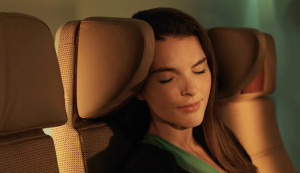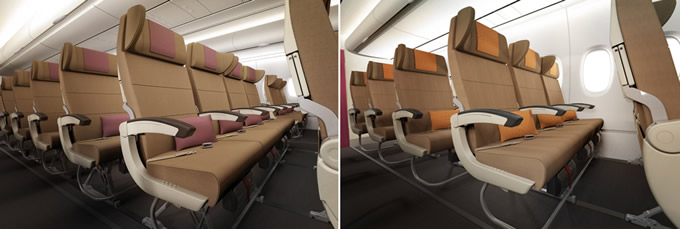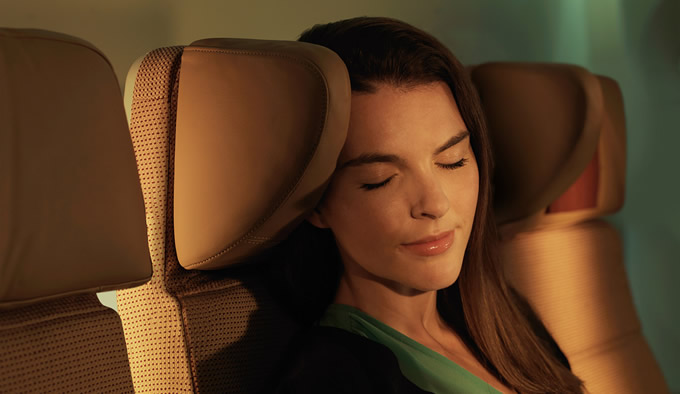 This article is re-published with kind permission of “www.airlinetrends.com”.
This article is re-published with kind permission of “www.airlinetrends.com”.
At airlinetrends.com we love smart design innovations, especially in the space-constrained Economy cabin. Think Air New Zealand’s innovative Skycouch (which will also be installed on China Airlines’ upcoming B77-300ERs), as well as the airline’s cleverly designed headrest pillows.
Economy Smart Seats
Lost a bit in the press blitz around Etihad’s new über-premium A380 comes a smart design innovation of the airline’s new Economy seats. The so-called ‘Economy Smart Seats’ (video here) feature a ‘fixed wing’ headrest, designed to provide a firm surface for passengers to lean on while sleeping.
The new Economy seats will first appear on Etihad’s A380 and Boeing 787-9 Dreamliners. On the A380, the economy seats will be nearly 19 inches wide and arranged in a 3-4-3 fashion with a 31-32 inch pitch. On Etihad’s Boeing 787 the seats will be configured 3-3-3 with a seat width of 17.2 inches and seat pitch ranging from 31 to 33 inches. Each Economy Smart Seat reclines 6 inches and has adjustable lumbar support.
Etihad Design Consortium
Etihad’s new interiors are the work of the so-called Etihad Design Consortium, which consists of British agencies Acumen Design Associates, Factorydesign and Honour Branding. Acumen has been responsible for seating for First Class, Business, and Economy, while Factorydesign was assigned passenger experience and interiors elements such as galleys, lavatories and passenger destination zones. Honour Branding was responsible for the coordination of the project and advising Etihad on the innovation process.
 In an interview via email, Acumen Design’s Creative Director John McKeever – who together with senior designer Richard Nicholas has been responsible for the design and implementation of Etihad’s new Economy Smart Seat – explains the ideas behind the novel headrest design in more detail.
In an interview via email, Acumen Design’s Creative Director John McKeever – who together with senior designer Richard Nicholas has been responsible for the design and implementation of Etihad’s new Economy Smart Seat – explains the ideas behind the novel headrest design in more detail.
What type of seat has been used for Etihad’s Economy Smart Seat?
The seat is a highly customised version of the Zodiac US (formerly Weber Aerospace) 5751 seat model. It is an evolution of the product Etihad currently fly on their wide body fleet.
Has the choice for a fixed headrest support been the response to findings from passenger surveys?
Passenger focus groups and co-creation sessions (Big Talks) were carried out all across the world (Abu Dhabi, London, Sydney and New York) at the very beginning of the project with Etihad’s frequent flyers and other airline passengers.
Some radical economy concepts and insights came out of these early co-creation sessions which helped to inform our early design work. The early ‘blue sky’ concepts played with different layouts, heights, direction of travel, functionality, privacy, etcetera, all of which had the aim of giving the economy passenger a much more enjoyable and special customer experience than is currently on offer today.
As the project progressed, the economics of the Economy Class drove the project towards the customisation of an ‘off the shelf’ product rather than a complete blue sky approach. However, the insights and lessons learned from the early research were carried over as much as possible.
For example the desire for privacy, individuality and comfort whilst relaxing and sleeping were still high on the agenda. One of the main design features that remained throughout the project was the large fixed wing headrest which has the following benefits:
– It provides a large comfortable padded surface to sleep against and provides excellent support for the passengers head. People commented in the early research sessions that the flexible ears you find on most existing economy seats never provide enough support, so rectifying this common complaint was a key driver for the design.
– The asymmetric design of the fixed wings also allowed us to create ‘zones’ within the cabin. One insight of the early research was that, unsurprisingly, there is no such thing as the ‘average’ passenger. From families travelling together, to individual business people, everyone has their own agenda and needs when travelling.
Early concepts had a much more radical approach to breaking up the cabin into different zones, providing privacy for the individual and space for groups and families travelling together. This thinking finally transpired into the asymmetric headrest arrangement throughout the cabin which creates ‘double’ seats on the centre quads (for people travelling together) and single seats on the outboard triples (more for individual passengers travelling alone). The fixed wing on one side of the headrest gives the perception of ownership of space and some privacy between you and your neighbour.
The headrest support reminds me of old train seats. Has this been a source of inspiration?
Not directly, but with Acumen’s history of train design, there has always been an awareness of trains that has probably filtered through. One of the goals from the outset of the Etihad brief was to bring back the ‘romanticism of travel’ and you can’t help but think of trains like Orient Express when this phrase is mentioned.
Are there any other elements of the seat that are worth mentioning?
The cabin is broken up into 3 colour zones (Jade, Ruby and Amber accents to the seat dress covers) to add another small element of individuality for passengers.
All the IFE components can be found conveniently on the seat back in front of you (with the exception of the front rows for obvious reasons). Each passenger gets an 11.1” Panasonic touch screen monitor, the very latest generation Panasonic handset, a USB connector, an AC power socket and a magnetic headphone jack.
The noise-cancelling headphones provide by Etihad connect magnetically to the headphone jack (similar to an Apple laptop power connector) and if pulled disconnect without breaking. No more accidentally getting yanked back if you forget to unplug your headphones when getting up from your seat! This small attention to detail was a key driver throughout the design and development of the seat.
There is also a personal coat hook and drinks holder and in addition to the standard literature pocket, there is a secondary mesh pocket for storing personal items.

